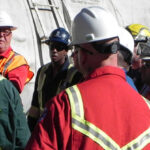
Crane operations can often put people at great risk of injury and fatality, as well as incurring great costs when they go wrong.
Due to the hazards and associated risks involved in crane operations, it is therefore important to follow a safe system of work in order for the lifting operations to be carried out in a safe manner.
The objective of the safe system of work is that all hazards and risks associated with and all factors affecting lifting operations are duly considered, communicated, well understood and controlled by the personnel involved in the crane operations.
LOLER Requirements for Lifting Operations
LOLER Regulation 8 from LOLER Approved Code of Practice and Guidance stipulates the planning of lifting operations.
All lifting operations, no matter how simple or routine, need to be planned by a person competent for the purpose who has an understanding of the principles involved, the equipment to be used, the nature of the load, the environment in which the lift is to be made and any other factors which may affect the operations
The person planning the lifting operations should be appropriately trained and have the requisite knowledge and expertise of planning lifting operations.
The plan should set out clearly the actions involved at each step of the operation and identify the responsibilities of those involved. The degree of planning and complexity of the plan will vary and should be proportionate to the foreseeable risks involved in the work.
Hazards Associated with Crane Operations
- Positions of people within the lifting operation area.
- Environmental conditions
- Dynamic forces on loads
- Lifting dangerous goods
- Blind lifts
- Proximity hazards
- Overloading of lifting equipment
- Lack of inspection/maintenance
- Operator error/incompetency
- Poor rigging
- Poor communication
- Lifting loads over live plant
- Equipment failure
- Falling of load/dropped objects
- Unauthorised personnel entry
- Not following agreed procedures
- Poor planning/supervision
- Deck space/Lay down area constraints
- Defective/Damaged slings and other appliances
- Conflicting activities
Hazard Control Measures for Crane Operations
- Do not exceed the lifting capacity (SWL) of the crane.
- If unsure of the lifting capacity, always check the rated lifting capacity chart. Lifting capacity varies with the boom length and working radius.
- Always check that all safety devices and warning systems are functioning properly.
- Do not operate a crane if any of the safety devices or warning systems are faulty.
- Avoid sudden movement or violent operation of the crane.
- Operate the levers and pedals smoothly. Start, accelerate, decelerate, articulate and stop the crane smoothly and securely.
- When lifting long loads tie a tag line to each end of the load. This will prevent the load from swinging whilst it is being lifted.
- Do not operate the crane if you are tired or cannot concentrate on the job.
- Always be alert and watch that the boom or the suspended load does not collide with people or buildings and the load does not collide with the boom.
- Never leave a suspended load unattended. When leaving the crane, always lower the load to the ground, switch off the engine, lock the crane and take the keys with you.
- Check that the total weight of the load (including the weight of slings, hook, and attachments) is below the rated capacity of the crane.
- Check that the number of parts of the line on the winch rope is a standard number according to the rated lifting capacity.
- Check that the slings are properly positioned to lift the load above its center of gravity.
- When the load just leaves the ground pause until it stops swinging. Confirm that the load is stable before continuing to hoist.
- Ensure that the slings should be of the right capacity and in good condition.
- Check that the lifting slings do not get tangled or twisted with each other during the lifting operations.
- Place a protector (some soft material) to prevent the slings from damage where it comes into contact with the corner of the load, and elsewhere where the sling is prone to damage.
- Never lift the load off the ground by luffing or extending the boom. Wait until the load is just off the ground before luffing or extending the boom.
- Do not move the suspended load above people’s heads.
- Before moving the load sideways check that it is safe to do so and the path of the load or crane should be clear of people or obstructions.
- Never drag a load sideways, hoist it diagonally or drag it towards the crane. Luffing or hoisting to drag the load sideways or lift it diagonally subjects the crane to forces it was not designed for. These additional forces will damage the boom or cause the crane to tip over. Follow the banksman and lift the load vertically.
- Barriers or barricades should be in place to prevent unauthorised personnel from encroaching the lifting operation zone.
- Visually and functionally inspect the crane before use. Check for damage, wear, and proper operation of all functions.
- Ensure the crane is only operated by qualified and competent operator with the proper certifications and training on the equipment.
- Crane operations should only be carried out in a suitable environmental conditions.
Primelift Safety Resources Limited provides crane operations training in accordance to relevant standards and regulations.
Contact us on www.primeliftsafetyng.com. Call us on +2348037957878 or Email us at training@primeliftsafetyng.com.










